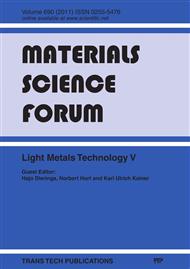p.41
p.45
p.49
p.53
p.57
p.61
p.65
p.69
p.73
Anisotropy of Flow during Forging of Rolled AZ31B Plate in Transverse Direction
Abstract:
Forging of a rib-web shape in rolled AZ31B magnesium alloy was conducted in the transverse direction at speeds of 0.01-10 mm s-1 in the temperature range 300-500 °C with the objective of validating the flow anisotropy. The finite element programme DEFORM was used to simulate the forging process to obtain the local values of strain and strain rate. Forgings done along the transverse direction at temperatures higher than 400 °C resulted in a symmetrical cup-shape while those done at lower temperatures exhibited an elliptical boat-shape with the major axis coinciding with the rolling direction and the minor axis aligning with the normal direction. This anisotropy of flow was due to the strong basal texture in the rolled plate and the dominance of prismatic slip at lower temperatures. At higher temperatures, pyramidal slip dominates along with cross- slip as the recovery mechanism, which reinstates the symmetry of flow by destroying the initial texture.
Info:
Periodical:
Pages:
57-60
Citation:
Online since:
June 2011
Keywords:
Price:
Сopyright:
© 2011 Trans Tech Publications Ltd. All Rights Reserved
Share:
Citation:


